Badly in need of funds for his ashram, Tagore sought donations from abroad notably England and was dismayed to encounter the cool British snub. This was a fallout of his strong denouncements against the British imperialistic attitudes as well as his relinquishment of the knighthood. Yet the poet in him keenly empathised with the pain of war-torn Europe. He visited many countries and reached out to other philanthropists who sympathised with his cause. Thus was born, Visva-Bharati, a nest formed in the universe with the purpose of sheltering all world ideologies without any clashes. As an undergraduate student of English Literature, Sutapa spent four halcyon years at Visva-Bharati University. She profiles the institution in Santiniketan, as Special Feature, exclusively for Different Truths.
An emerald set in the undulating red clay of Birbhum district of West Bengal is Visva-Bharati University, Poet Rabindranath Tagore’s renowned institution. From times immemorial, it has been universally synonymous with India’s heritage, but today it seems an isolated Shangri-La, in a materialistic world of ever-increasing cynicism. Has his original ideology withstood the test of time and if so, what is its significance today?
Since the very beginning of his childhood, Tagore had suffered the unimaginative, constrictive, and rigid educational system of his times. So he was determined that his own children would not be subjected to a similar torture. Emulating the forest ashrams of yore, Tagore conceived and established the Brahmacharya Vidyalaya at Kutir Bari on the sprawling family estate at Santiniketan, in 1901. Far away from the urban confines of Calcutta, the literary genius wanted his students to imbibe a Wordsworthian education, learning at the feet of Mother Nature herself. He began with five students including his own son, Rothindranath. The poet taught them the Ramayana and the Mahabharata. Soon, his wife found she was running a full-fledged ashram.
Badly in need of funds for his ashram, Tagore sought donations from abroad notably England and was dismayed to encounter the cool British snub. This was a fallout of his strong denouncements against the British imperialistic attitudes as well as his relinquishment of the knighthood. Yet the poet in him keenly empathised with the pain of war-torn Europe. He visited many countries and reached out to other philanthropists who sympathised with his cause. Thus was born, Visva-Bharati, a nest formed in the universe with the purpose of sheltering all world ideologies without any clashes. This concept was welcomed, encouraged and supported especially by philanthropists and intellectuals from America. In 1918, the Brahmacharya Vidyalaya expanded into the Visva-Bharati University.
Tagore’s perception was to create a scholarly hub that connected ancient eastern philosophies and art with western ideologies and scientific thought. The university at Santiniketan turned into a worldwide centre of enriching intercourse and illuminating experiences between exponents of all sorts. All those aspiring to work, learn and converse in a liberal, versatile, and enlightened environment flocked to this university. Its mission reflected in its motto: ‘Yatra Viswam Bhavataya Ek Nidam’ (Where the Whole World Finds Shelter).
After India attained freedom from the British yoke, Visva-Bharati attained the status of a central government institution. The honour of being its first chancellor was bestowed upon Pandit Jawaharlal Nehru, the first Prime Minister. Ever since then this designation has been held by all erstwhile prime ministers of India.
Today, the university encompasses several colleges and a school. Ananda Pathshala and Pathu Bhavan are for schooling from nursery to class XII. Vidya Bhavan (College of Humanities), Shikha Bhavan (College of Sciences), Sangeet Bhavan (College of Music), Kala Bhavan (College of Fine Arts) offer courses for a diploma, undergraduate, and postgraduate degrees and research facilities. Sriniketan, a few kilometres away, is the location of the College of Agriculture that also supports the development of small-scale and cottage industries among the rural and tribal communities of the region. The academic community, both faculty and students, is entirely residential at Visva-Bharati University, an institution self-sufficient so far as its medical, banking, postal, and shopping facilities are concer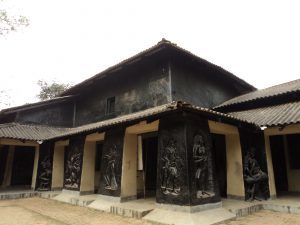 ned.
ned.
In keeping with the ashram’s ambience, certain norms are strictly adhered to and all visitors are requested to respect them. Simplicity in lifestyle is a must. Students are not permitted expensive belongings, nor can they sport extravagant jewellery. Usually, flowers are used as ornaments during festivals and special occasions. School children wear hand-woven kurta-pyjamas, skirt-tops, or sarees in ochre yellow and white. Though there is no dress code for the senior students, everybody, teachers included, dress in comfortable kurtas, jeans, and sarees. The stylish seek to express aesthetic harmony through textile colours and in artifices garnered from Nature both in their garments and decor.
Everybody eats in communal dining halls that serve simple, nutritious, healthy food. Hostels and kitchens are spick and span and undergo regular inspections. The ashram security unit ensures that no motorised vehicles enter the ashram and that nobody indulges in smoking, consuming alcohol, or behaving in an objectionable manner inside the premises.
To avoid religious factionalism, no religious festivals are celebrated inside the ashram. Classes are held under the green canopy of mango or sal trees and if it rains, the students take a rain check to enjoy the bounty of Nature. Belief in an all-pervasive Supreme Being is encouraged and the daily prayer service is a beautiful amalgamation of recitals from the ancient Vedas and Tagore’s own musical offerings to the Divine Being.
Nature festivals are a part of Santiniketan life. The session begins in July, commencing with Barsha Mangal, the rain festival. Singers, dancers, and musicians perform in tune with Tagore’s lyrics describing the rainy season. This is followed by frantic rehearsals for the annual drama contest. Each Bhavan presents its repertoire, selections from Shaw, Shakespeare, Russian drama, Sanskrit plays, and Tagore’s own works. The entire stage decor, costumes, sometimes masks, special effects, lighting created by the students is professional and aesthetic enough to match and surpass international standards.
November brings Nandan Mela. Nandalal Bose was not just a pioneer of Modern Indian Art, he was also the Principal of Kala Bhavan. Nandan Mela is held to mark his birth anniversary where Kala Bhavan students exhibit and sell handicrafts, jewellery, and stationary made from clay, fibres, lentils, wood, metal, along with woven textiles, sketches, paintings, sculptures, and prints at throwaway prices.
Winter heralds Poush Mela, wherein gather handicraft specialists from all over the country displaying their wares. Musical soirees by renowned folk singers, classical and Tagorean artists are part of this fair. A famous highlight is the Baul convention, a gathering of the Baul singers. This is an enjoyably educative experience to both the uninitiated and the blasé. At the Pousha Mela, one should not be too surprised to rub shoulders with stalwarts such as the Buddhadev Guha, Mrinal Sen, the late Satyajit Ray, Sandeep Ray, late M.F. Hussain and the likes.
The piece-de-resistance is the Spring Festival or Dol Utsav. The day commences with an early morning procession dance, participated by representatives from all segments of the student body: the nursery 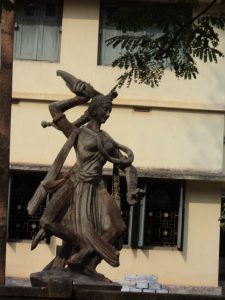 babes to the 40-year-old ex-students. They dance to the strains of ‘O Re Grihobashi, Khol daar, Khol Laglo je Dol’ (Oh Home Dwellers! Open your doors for the carnival of colours is here). Clad in bright yellow, the dancers celebrate the joys of spring and call out to open all doors to her beauty. This is followed by recitals, songs and more dances dedicated to the season staged in the Amra Kunj (Mango Garden). The rest of the day is spent showering friends and acquaintances with gulal and flower petals. Students seek blessings of their teachers by marking their feet with coloured powder. The festival culminates in a three-hour dance drama held on an open stage with a backdrop of tall trees with the audience seated on a green slope under the full moon’s light. The only applause deemed suitable is the chanting of ‘Sadhu Sadhu’. Hand clapping is considered a crudity in the ashram.
babes to the 40-year-old ex-students. They dance to the strains of ‘O Re Grihobashi, Khol daar, Khol Laglo je Dol’ (Oh Home Dwellers! Open your doors for the carnival of colours is here). Clad in bright yellow, the dancers celebrate the joys of spring and call out to open all doors to her beauty. This is followed by recitals, songs and more dances dedicated to the season staged in the Amra Kunj (Mango Garden). The rest of the day is spent showering friends and acquaintances with gulal and flower petals. Students seek blessings of their teachers by marking their feet with coloured powder. The festival culminates in a three-hour dance drama held on an open stage with a backdrop of tall trees with the audience seated on a green slope under the full moon’s light. The only applause deemed suitable is the chanting of ‘Sadhu Sadhu’. Hand clapping is considered a crudity in the ashram.
Along with all these activities, the academic programmes go on at their own pace with examinations held at the right times. Students of this unique university flocking in large numbers from other countries are exposed to a sophisticated academic, culturally rich, artistic milieu in the form of their faculty. Their academic pursuits are cognizant of the enriching expertise of the very best in the field. Their perceptions are developed and they are encouraged to pursue their individual creative aptitude under the tutelage and guidance of renowned craftsmen of international stature. It is not uncommon to enter a classroom and find that day’s lecture being taken by the renowned Economist Amartya Sen, himself an ex-student of Pathu Bhavan.
Being a residential institution the student-teacher cohesion and rapport is very strong and spills from the classrooms on to playing fields, dining halls, and even teachers’ homes. Informality is the key as the teachers are addressed with their names with a ‘da’ or ‘di’ appended to it. The school has a home-room-system with each teacher playing a surrogate parent to a specific student group through their school years. It is heartening to watch students surrounding a teacher demanding a puri-sabji or ice cream treat at his home! Channelising values or imparting life skills or personality guidance is that much more effective in this environment. The ideals of ashram life namely respect for self and others, appreciation of hard labour, simple living and high thinking, creativity, finding compassion and tolerance for different ideas, national pride, self confidence and conviction of principles, positive thinking and so much more is imbibed as a matter of routine not only through adages but also by personal precedents.
Far from the madding crowd, Visva-Bharati University at Santiniketan could seem an antithesis and its ideology archaic is this world of a cutthroat rat race. Yet the more one stays within these sylvan surroundings the more one merges into its beauty, harmony, music, and serenity till its fingers touch the very soul. The external contentment internalises, tensions and cares to retract, and calm reigns within. A balance is struck and one feels grounded amidst the turmoil. There is a sense of homecoming. It is the essence we seek all our lives but often cannot find. Santiniketan fulfils a need, cradles us in her arms, this abode of peace, an oasis in a land parched of sanity.
In the depths of our core soon emerges a chord that responds to Santiniketan’s tender caress and Tagore has the last say:
Far we may go but never will we be distant from Santiniketan.
The lutes of our hearts are strung to her sweet music.
Her symphony binds us forever into the fraternity of Nature.
©Sutapa Basu
Photos by the author
#Shantiniketan #Ashram #VisvaBharatiUniversity #Nature #Tagore #KalaBhavan #NandanMela #VidyaBhavan #SangeetBhavan #SikshaBhavan #PathuBhavan #RabindranathTagore #Bolpur #AmraKunj #Nature #LearningInNature #TributeToTagore #DifferentTruths

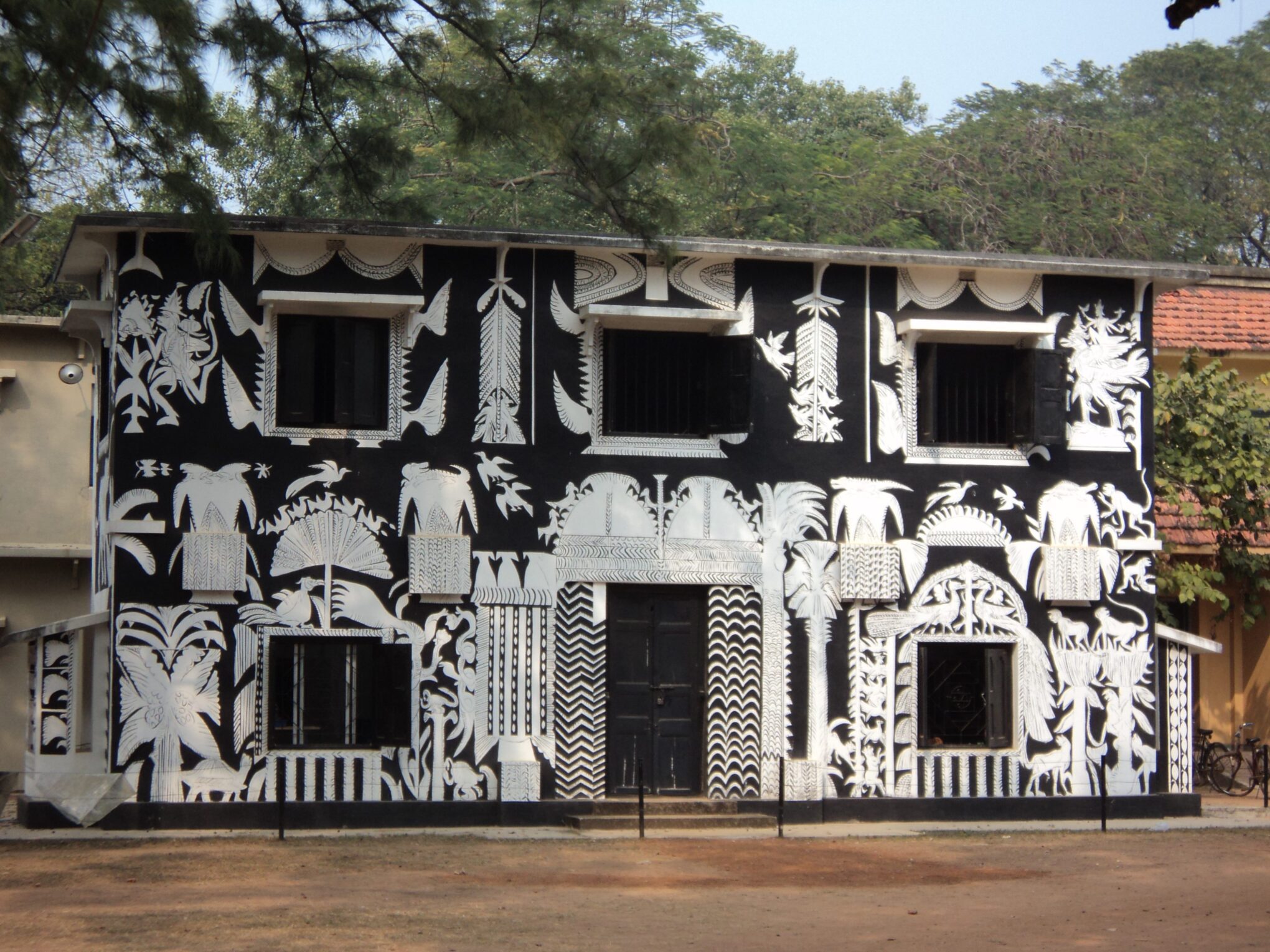
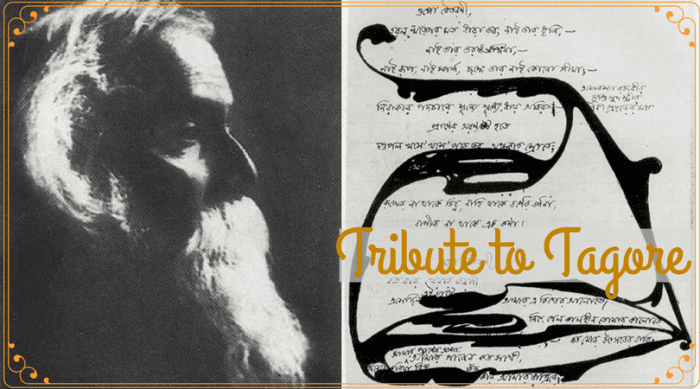
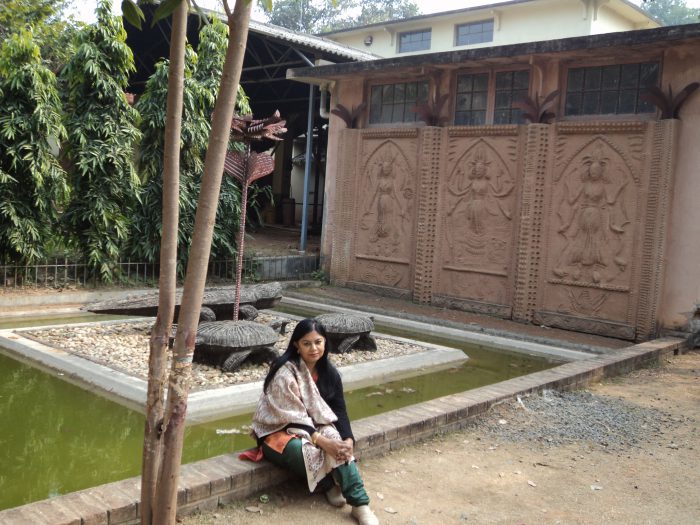
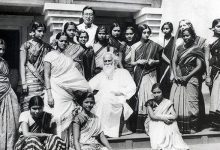


 By
By
 By
By
 By
By
 By
By
What a beautiful ode to Tagore and his Shantiniketan.The clear explanations and vivid descriptions bring across the spirit of this wonderful institution. Thank you Sutapa for the eye- opening tour…